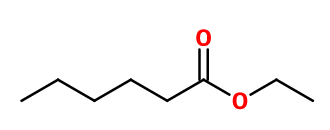
Photo credits: ScenTree SAS
| Company | Ingredient Name | ID | Comments | Naturality | Certifications | Purity | Latin name | Treated part | Geographical origin | MOQ |
|---|---|---|---|---|---|---|---|---|---|---|
|
|
ETHYL CAPROATE | M_0050625 |
Visit website
|
Naturel | - | - | - | - | - |
General Presentation
-
CAS N° : 123-66-0
-
EINECS number : 204-640-3
-
FEMA number : 2439
-
FLAVIS number : 09.060
-
JECFA number : 31
-
Appearance : Colorless liquid
-
Density : 0,869
-
Volatility : Head
-
Price Range : €
Physico-chemical properties
-
Molecular formula : C8H16O2
-
Molecular Weight : 144,21 g/mol
-
Log P : 2,8
-
Fusion Point : Donnée indisponible.
-
Boiling Point : 168°C
-
Detection Threshold : 0,3 à 5 ppb (0,0000005%)
-
Optical rotation : Donnée indisponible
-
Vapor pressure : Donnée indisponible
-
Refractive Index @20°C : Donnée indisponible
-
Acid Value : Donnée indisponible.
-
Flash Point : 53°C
Uses
Uses in perfumery :
Ethyl Caproate is used in exotic, fruity, tropical fruits and yellow fruits notes to ripen fruits. Also used in cheese notes, fruity and floral accords. Can accompany aldehydes in a rose accord.
Year of discovery :
Data not available.
Natural availability :
Ethyl Caproate is present in many fruits such as apple, guava or banana and in some cheeses, among others. There is also an Ethyl Caproate of natural origin.
Isomerism :
Ethyl Caproate does not have any isomer used in perfumery.
Synthesis precursor :
Ethyl Caproate is not a precursor to the synthesis of another compound of olfactory interest.
Synthesis route :
Ethyl Caproate is synthesized by an esterification reaction between Hexanoic Acid and ethanol, using acid catalysis.
Regulations & IFRA
Allergens :
This ingredient does not contain any allergen.
IFRA 51th :
This ingredient is not restricted for the 51th amendment


